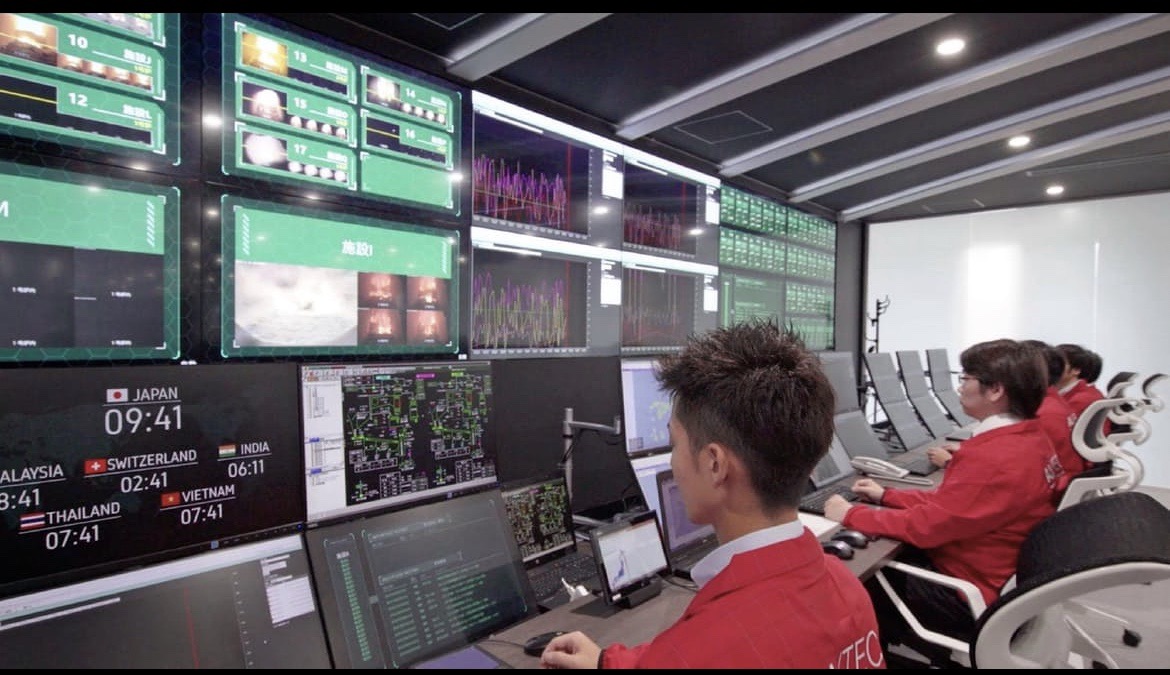Hitachi Zosen holds a domestic market share of 20 to 30% in plant construction
Hitachi Zosen uses digital technology to visualize waste disposal. We analyze data on when, where, and how much garbage is generated, and create the optimal operation route for garbage trucks. Artificial intelligence (AI) will also be used for incineration and monitoring at waste incinerators, reducing the manpower required for operation to one-third. Build a comprehensive digital service and increase the productivity of waste disposal.

A garbage collection point in the Kanto region. The person in charge of picking up the garbage bag and putting it in the collection truck has a wristwatch-like terminal wrapped around his wrist. The terminal has a built-in sensor that detects the number of times the garbage truck is thrown into the collection vehicle from the acceleration and tilt of the arm. By linking with information such as the Global Positioning System (GPS), you can grasp the amount of garbage at the collection point.
Hitachi Zosen started such an experiment in January. Accumulate data and predict the amount of waste generated at each collection point. This is read into AI by machine learning to create an efficient operation route for collection vehicles. In the past, it relied on the experience of experts.
In the past, a similar experiment was conducted in Niigata prefecture, and about 9 people in charge of garbage collection acquired data for a total of 1000 hours. By recreating the operation route with AI, the mileage of the collection vehicle was reduced by 20% and the working time was reduced by 10%.
The collection vehicle returns to the incinerator when the garbage to be loaded is full. It was difficult to determine the timing, and "there was an example of returning to the incinerator facility even though the work would be completed in one more place" (Hitachi Zosen's Engineering Business Unit Manager Hideo Sato). It is said that such waste can be reduced.
Hitachi Zosen is the largest manufacturer of waste incineration facilities with a domestic market share of 20 to 30%. The related "environment / plant business" accounts for about 70% of consolidated sales (408.5 billion yen in the fiscal year ending March 2021). Half of this is the construction of waste incineration facilities, and the other half is the outsourced operation of the facilities.
According to the Ministry of the Environment, the number of waste incineration facilities nationwide at the end of FY2008 was 1056, a decrease of 13% from the end of FY2011. In order to reduce the financial burden, there are an increasing number of cases where multiple local governments jointly operate facilities.
Construction of incineration facilities is expected to taper off, and it is necessary to strengthen outsourced operations. Currently, about 50 facilities are outsourced from municipalities, including those under construction. Utilize digital technology to make a difference with competitor Takuma, JFE Engineering.
Use AI for incineration. Install the camera in the place where the garbage is stocked before putting it in the incinerator. AI analyzes the image and grasps the location of combustible waste such as paper and plastic, and non-combustible waste such as kitchen waste from the color and shape of the waste.
From the movement of the crane that carries the garbage to the incinerator, the degree of mixing of the garbage is recognized. Mix evenly with a crane to keep the temperature of the furnace constant. It leads to stable combustion and saves fuel. Such operations also depended largely on the experience of experts.
Hitachi Zosen aims to deliver the system to 5 facilities during the fiscal year ending March 2011 and 10 facilities by the fiscal year ending March 2014.
AI will also be used to monitor incineration facilities. A quadruped robot will soon patrol near the incinerator at a facility in Kyoto City, and will start an experiment to monitor the state of hydraulic pressure and piping. Automatically read piping and oil pressure instruments with a camera and record them in a daily report. Previously, 2 to 4 people checked each day.
In the future, we aim to catch signs of facility malfunctions by robots climbing steps and entering gaps in pipes that normally cannot be accessed by people.
According to the company, the number of employees per waste incineration facility is around 30. A series of digital technologies will enable one-third of the personnel to operate. We will promote the efficiency and increase the number of contracts for operating waste incineration facilities from local governments. The company plans to sell the developed technology to local governments that operate its own facilities, aiming for sales of 3 billion yen by 30 and 10 billion yen by 1950.
Waste disposal cost, heavy burden on local government
Municipalities are mainly in charge of collecting and operating incineration facilities for waste disposal. According to the Ministry of Internal Affairs and Communications, the cost of waste collection and disposal borne by local governments, including prefectures, will amount to 2,488.6 billion yen in FY2020. There is a great need for efficiency to save costs.
Many local governments outsource the operation of waste incineration facilities to companies such as Hitachi Zosen for the purpose of cost reduction, mainly in regions where the population is declining. It is said that there are many consultations from local governments that operate the facility on their own, such as "Is it possible to save labor because the financial situation is tight and the manpower of the facility cannot be secured?"
The total amount of waste discharged in Japan in FY2008 is 41.67 million tons, which is equivalent to 112 cups of Tokyo Dome. It has been pointed out that the use of digital technology has been delayed, although collection and incineration facilities are indispensable living infrastructure. If we improve our technology in Japan, we may be able to expand into overseas markets.






